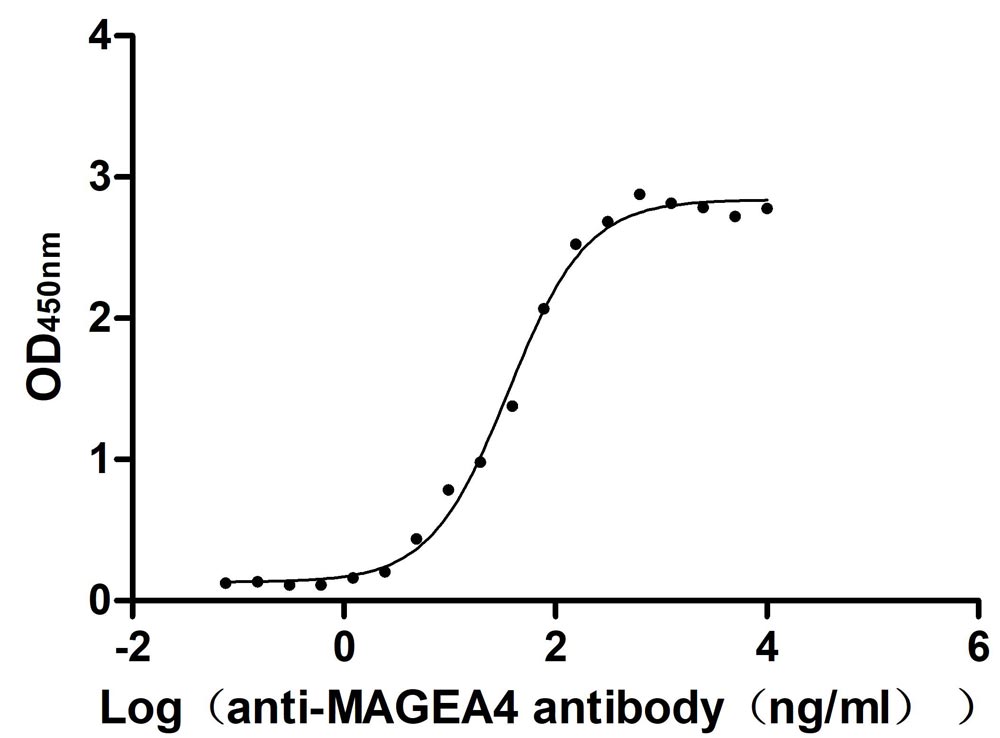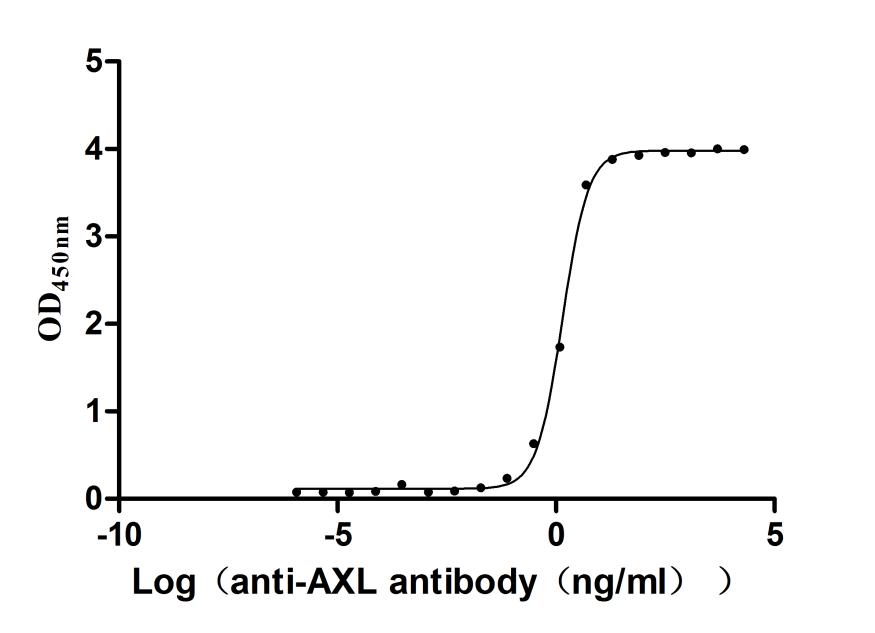Recombinant Human ATP-sensitive inward rectifier potassium channel 10 (KCNJ10)
-
中文名称:人KCNJ10重组蛋白
-
货号:CSB-CF012048HU
-
规格:¥9720
-
图片:
-
其他:
产品详情
-
纯度:Greater than 90% as determined by SDS-PAGE.
-
基因名:KCNJ10
-
Uniprot No.:
-
别名:KCNJ10; ATP-sensitive inward rectifier potassium channel 10; ATP-dependent inwardly rectifying potassium channel Kir4.1; Inward rectifier K(+ channel Kir1.2; Potassium channel, inwardly rectifying subfamily J member 10
-
种属:Homo sapiens (Human)
-
蛋白长度:Full Length
-
来源:in vitro E.coli expression system
-
分子量:58.5kDa
-
表达区域:1-379aa
-
氨基酸序列MTSVAKVYYSQTTQTESRPLMGPGIRRRRVLTKDGRSNVRMEHIADKRFLYLKDLWTTFIDMQWRYKLLLFSATFAGTWFLFGVVWYLVAVAHGDLLELDPPANHTPCVVQVHTLTGAFLFSLESQTTIGYGFRYISEECPLAIVLLIAQLVLTTILEIFITGTFLAKIARPKKRAETIRFSQHAVVASHNGKPCLMIRVANMRKSLLIGCQVTGKLLQTHQTKEGENIRLNQVNVTFQVDTASDSPFLILPLTFYHVVDETSPLKDLPLRSGEGDFELVLILSGTVESTSATCQVRTSYLPEEILWGYEFTPAISLSASGKYIADFSLFDQVVKVASPSGLRDSTVRYGDPEKLKLEESLREQAEKEGSALSVRISNV
Note: The complete sequence including tag sequence, target protein sequence and linker sequence could be provided upon request. -
蛋白标签:N-terminal 6xHis-SUMO-tagged
-
产品提供形式:Liquid or Lyophilized powder
Note: We will preferentially ship the format that we have in stock, however, if you have any special requirement for the format, please remark your requirement when placing the order, we will prepare according to your demand. -
缓冲液:Lyophilized from Tris/PBS-based buffer, 6% Trehalose
-
储存条件:Store at -20°C/-80°C upon receipt, aliquoting is necessary for mutiple use. Avoid repeated freeze-thaw cycles.
-
保质期:The shelf life is related to many factors, storage state, buffer ingredients, storage temperature and the stability of the protein itself.
Generally, the shelf life of liquid form is 6 months at -20°C/-80°C. The shelf life of lyophilized form is 12 months at -20°C/-80°C. -
货期:Basically, we can dispatch the products out in 1-3 working days after receiving your orders. Delivery time may differ from different purchasing way or location, please kindly consult your local distributors for specific delivery time.Note: All of our proteins are default shipped with normal blue ice packs, if you request to ship with dry ice, please communicate with us in advance and extra fees will be charged.
-
注意事项:Repeated freezing and thawing is not recommended. Store working aliquots at 4°C for up to one week.
-
产品描述:
The recombinant Human KCNJ10 protein is a cell-free system in vitro E.coli expressed Full Length protein. In cell-free systems, synthesis of the protein can be carried out in vitro using extracts of whole cells that are compatible with translation. These cell extracts contain all the molecules and enzymes that are needed to transcribe, translate, and post-translationally modify the recombinant protein. With additional supplements of cofactors, KCNJ10 proteins can be formed in a few hours. However, this system may not be applicable for the large-scale production of recombinant proteins. Advantages of this system include that proteins can be synthesized without cell culturing; also, it is possible to express many proteins together.
KCNJ10 is most expressed in glial cells of the brain, inner ear, and kidney. Glial KCNJ10 channels are responsible for extracellular K+ buffering, glutamate uptake, astrocyte development, and myelination. In the inner ear, KCNJ10 regulates K+ homeostasis and takes part in endocochlear potential production and maintenance, which is required for cochlear development and hearing. KCNJ10 contributes to K+ recycling and the generation of a negative membrane potential in the distal convoluted tubules (DCTs). Autosomal recessive mutations in the KCNJ10 gene lead to the multisystemic disorder SeSAME/EAST syndrome. -
Datasheet & COA:Please contact us to get it.
相关产品
靶点详情
-
功能:May be responsible for potassium buffering action of glial cells in the brain. Inward rectifier potassium channels are characterized by a greater tendency to allow potassium to flow into the cell rather than out of it. Their voltage dependence is regulated by the concentration of extracellular potassium; as external potassium is raised, the voltage range of the channel opening shifts to more positive voltages. The inward rectification is mainly due to the blockage of outward current by internal magnesium. Can be blocked by extracellular barium and cesium. In the kidney, together with KCNJ16, mediates basolateral K(+) recycling in distal tubules; this process is critical for Na(+) reabsorption at the tubules.
-
基因功能参考文献:
- results show that a glia-neuron interaction at the perisomatic space of LHb is involved in setting the neuronal firing mode in models of a major psychiatric disease. Kir4.1 in the LHb might have potential as a target for treating clinical depression. PMID: 29446379
- A novel mutation in the KCNJ10 and previously characterized mutation in KCNT1 were identified in boy with seizures and neurodevelopmental delay. KCNJ10 L218F mutation associated with disease resulted in reduced Kir current. PMID: 28747464
- rs17375748, rs1130183, rs12133079 and rs1186688 associated with sudden infant death syndrome PMID: 28520217
- kcnj10 plays a role in K(+) recycling across the basolateral membrane in corresponding nephron segments and in generating negative membrane potential--{REVIEW} PMID: 27122539
- Previous research had shown that Kir4.1 protein autoantibodies were specific for multiple sclerosis but they found that they weren't. PMID: 27074083
- This study identifies potential SNPs of KCNJ10 gene that may contribute to seizure susceptibility and anti-epileptic drug resistance. PMID: 25874548
- disruption of cav-1 decreases basolateral K(+) channel activity and depolarizes the cell membrane potential in the DCT1 at least in part by suppressing the stimulatory effect of c-Src on Kcnj10 PMID: 25848073
- anti-KIR4.1 antibody levels differed in multiple sclerosis patients during relapse and remission; as such, they may represent a marker of disease exacerbation PMID: 25392324
- This study showed that rs2486253, but not rs61822012, polymorphism of KCNJ10 gene was associated with childhood idiopathic generalized epilepsy. PMID: 25008907
- we confirmed the presence of anti-Kir4.1 antibodies in multiple sclerosis patients, but at a much lower prevalence than previously reported. PMID: 24756568
- KCNJ10 SNP is not associated with nonsyndromic enlargement of vestibular aqueduct in Chinese patients. PMID: 25372295
- No KIR4.1-specific antigen is detected in serum or cerebrospinal fluid of multiple sclerosis (MS) patients; the target antigen of MS remains elusive. PMID: 25008548
- This study observed a decrease of astroglial KIR4.1 but not glial fibrillary acidic protein IR. In chronic inactive and remyelinating MS lesions, KIR4.1 IR was restored on astrocytes and found in a subset of presumably new myelinating oligodendrocytes. PMID: 24777949
- study provides an explanation for the pathophysiology of the p.A167V KCNJ10 mutation, which had not been considered pathogenic on its own; findings provide evidence for functional cooperation of KCNJ10 and KCNJ16; in vitro ascertainment of KCNJ10 function may necessitate co-expression with KCNJ16 PMID: 24193250
- Mislocalization of the Kir4.1 channels contributes to renal salt wasting. PMID: 24561201
- KCNJ10rs1130183 did not contribute to risk of seizure susceptibility. PMID: 24378235
- Study confirms that EAST syndrome can be caused by many different mutations in KCNJ10 that significantly reduce K+ conductance. PMID: 21849804
- Ordered disorder of the astrocytic dystrophin-associated protein complex in the norm and pathology. PMID: 24014171
- Serum antibodies to KIR4.1 are found in the majority of children with acquired demylinating disease but not in children with other diseases or in healthy controls. PMID: 24415573
- the modulation of tyrosine phosphorylation of KCNJ10 should play a role in regulating membrane transport function in DCT1. PMID: 23873931
- We found no evidence for a significant association between mutations of KCNJ10 and FOXI1 with SLC26A4 in Pendred syndrome/enlarged vestibular aqueducts. PMID: 23965030
- The results of this study indicated that alterations in expression of Kir4.1 occurring in epilepsy-associated lesions are possibly influenced by the local inflammatory environment and in particular by the inflammatory cytokine IL-1beta. PMID: 23270518
- Oligodendrocyte precursor cells establish themselves progressively through postnatal upregulation of Kir4.1 potassium channels. PMID: 23392672
- The subcellular co-localisation of K(ir)4.1 and AQP4 in the supporting cells of the cochlea described in this study resembles that of the astroglia of the central nervous system and the glial Mueller cells in the retina. PMID: 22802001
- This study demonistrated that Loss of perivascular Kir4.1 potassium channels in the sclerotic hippocampus of patients with mesial temporal lobe epilepsy. PMID: 22878665
- No KCNJ10 mutations were present in bilateral deafness patients with inner ear malformation. PMID: 22412181
- Downregulation of Kir4.1 channels aggravates the visual impairment caused by the initial photoreceptor degeneration. PMID: 22055109
- Gain-of-function defects in Kir4.1 causes dysfunction in astrocytic-dependent potassium buffering and contributes to autism/epilepsy phenotype by altering neuronal excitability and synaptic function. PMID: 21458570
- extracellular volume recordings indicate that compromised K(+) spatial buffering in brain underlies the epilepsy phenotype associated with human KCNJ10 mutations PMID: 21748805
- Role of KCNJ10 function in the physiology of proximal and possibly also the distal retina. Impact of KCNJ10 mutations on the electroretinogram in four unrelated patients with EAST syndrome. PMID: 21300747
- Mutations in the K+ channel gene KCNJ10 (Kir4.1) cause the autosomal recessive EAST syndrome which is characterized by epilepsy, ataxia, sensorineural deafness, and a salt-wasting tubulopathy. PMID: 21221631
- This study suggests that the SNPs within the kcnj10 genes we examined do not play a major role in schizophrenia in the Han Chinese population. PMID: 20933057
- CaR decreases cell surface expression of Kir4.1 channels via a mechanism that involves Galpha(q) and caveolin. PMID: 21084311
- Perturbed pH gating may underlie the loss of channel function for the disease-associated mutant Kir4.1 channels and may have important physiologic consequences. [review] PMID: 21088294
- The Kir4.1 channel transgene plays a role in setting the membrane potential of glial cells and in maintaining potassium permeability in glial-conditioned Kir4.1 knock-out mice. PMID: 21106816
- SLC26A4, FOXI1 and KCNJ10 are not major determinants in unilateral deafness and enlarged vestibular aqueduct PMID: 20621367
- When expressed in CHO and HEK293 cells, the KCNJ10 mutations R65P, G77R, and R175Q caused a marked impairment of channel function PMID: 20651251
- Variations in the AQP4 and the KCNJ10/KCNJ9 region are likely to be associated with temporal lobe epilepsy. PMID: 19864112
- molecular analysis on chromosome 1q as a candidate gene for Type 2 diabetes in Pima Indians PMID: 12401729
- Arg271Cys missense variation in KCNJ10 (or a nearby variation) is related to general seizure susceptibility in humans. PMID: 15120748
- Our results support previous evidence that the common KCNJ10 Arg271Cys missense variation influences seizure susceptibility of common IGE syndromes. PMID: 15725393
- Calcium-sensing receptor interacts directly with Kir4.1 and Kir4.2 and can decrease their currents. PMID: 17122384
- The results showed that the expression of Kir 4.1 mRNA and protein, as well as the Kir 4.1 immunoreactivity score (IRS), increased markedly with increasing pathologic grade. PMID: 18191638
- identifY previously unidentified KCNJ10 missense or nonsense mutations on both alleles in all subjects affected by a unique human syndrome, and establish the essential role of basolateral K(+) channels in renal electrolyte homeostasis. PMID: 19289823
- Mutations in KCNJ10 cause a specific disorder. Our findings indicate that KCNJ10 plays a major role in renal salt handling and possibly also in blood-pressure maintenance and its regulation. PMID: 19420365
- mutations in the inwardly rectifying K(+) channel gene KCNJ10 are associated with nonsyndromic hearing loss in carriers of SLC26A4 mutations with an EVA/PS phenotype. PMID: 19426954
显示更多
收起更多
-
相关疾病:Seizures, sensorineural deafness, ataxia, mental retardation, and electrolyte imbalance (SESAMES)
-
亚细胞定位:Membrane; Multi-pass membrane protein. Basolateral cell membrane.
-
蛋白家族:Inward rectifier-type potassium channel (TC 1.A.2.1) family, KCNJ10 subfamily
-
组织特异性:Expressed in kidney (at protein level).
-
数据库链接:
HGNC: 6256
OMIM: 602208
KEGG: hsa:3766
STRING: 9606.ENSP00000357068
UniGene: Hs.408960
Most popular with customers
-
Recombinant Human Melanoma-associated antigen 4 (MAGEA4) (Active)
Express system: Mammalian cell
Species: Homo sapiens (Human)
-
Recombinant Human C-C chemokine receptor type 8 (CCR8)-VLPs (Active)
Express system: Mammalian cell
Species: Homo sapiens (Human)
-
Recombinant Human CUB domain-containing protein 1 (CDCP1), partial (Active)
Express system: Mammalian cell
Species: Homo sapiens (Human)
-
Recombinant Rat Gastric inhibitory polypeptide receptor (Gipr), partial (Active)
Express system: Mammalian cell
Species: Rattus norvegicus (Rat)
-
Recombinant Human Tyrosine-protein kinase receptor UFO(AXL),partial (Active)
Express system: Mammalian cell
Species: Homo sapiens (Human)


















